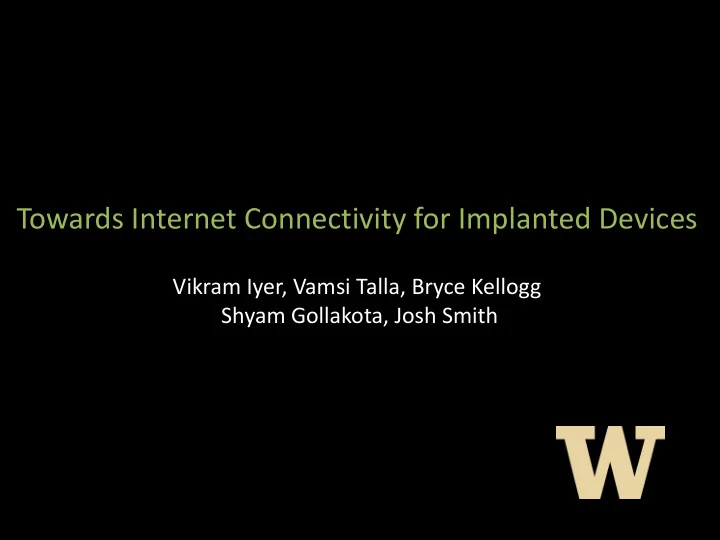

Towards Internet Connectivity for Implanted Devices Vikram Iyer, Vamsi Talla, Bryce Kellogg Shyam Gollakota, Josh Smith
Brain implants for reanimation of limbs Need wireless connectivity to make this practical and safe Brown University - Guardian News & Media Ltd
Contact lenses that measure blood sugar Google- Business Computing World
Contact lenses that measure blood sugar
Can implanted devices talk to smartphones?
Conventional radios consume too much power Replacing implant batteries requires surgery
Problem: Creating RF signals is power expensive Solution: Recycle RF signals from external devices
Interscatter Communication Recycle Bluetooth signals to create WiFi Creates WiFi packets for 28 μW of power
Our Contributions Build first Wi-Fi contact lens and brain • implant proof of concepts Transform wireless transmissions from • one technology to another, on the air Ø Bluetooth to 2-11Mbps Wi-Fi and ZigBee
System Requirements Receiver Source Contact lens 1. Commodity devices à Bluetooth/Wi-Fi 2. Minimize implant ON time à Send data at high rate 3. Source isn’t sending data à Minimize bandwidth
Problem: Bluetooth and WiFi are different protocols Challenge 1: Different modulation Frequency Shift Keying Phase Shift Keying Challenge 2: Different frequencies and bandwidth
Our Approach 1) Transform BLE transmissions into Step 1: Transform Bluetooth single tone signals transmissions into single tone signals Step 2: Reflect the single tone signal to create our own Wi-Fi packets
How do we create a single tone from Bluetooth? Bluetooth uses frequency shift keying f low = 0 f high = 1
How do we create a single tone from Bluetooth? Bluetooth uses frequency shift keying 0 0 1 0 0 1 Transmitting all ‘0’ or ‘1’ bits creates a single tone
How do we create a single tone from Bluetooth? Problem: Bluetooth whitens the data Original Payload: 11111 Pseudorandom + bit generator Whitened Payload: Seed 11001 Seed is set to the channel number à Whitening sequence is constant
How do we create a single tone from Bluetooth? Solution: Reverse engineer whitening sequence Problem: Bluetooth whitens the data Original Payload: 11111 Whitening sequence Pseudorandom + bit generator Whitened Payload: Seed 11001 00000 Seed is set to the channel number Transform Bluetooth to a single tone in user space à Whitening sequence is constant
Our Approach 1) Transform BLE transmissions into Step 1: Transform Bluetooth single tone signals transmissions into single tone signals Step 2: Reflect the single tone signal to create our own 802.11b packets
How do we create WiFi packets? Problem: Bluetooth and WiFi use different frequencies First-Order Solution: Use Passive WiFi (NSDI ‘16) BLE 38 Smart contact lens
How do we create WiFi packets? First-Order Solution: Use Passive WiFi (NSDI ‘16) 0 1 0
Problem: Passive WiFi creates mirror copy outside ISM band Outside ISM 2.4 GHz ISM Band band BLE 38 Wi-Fi CH11 Mirror Copy
Solution: First single sideband backscatter Key Idea: Cancel mirror copy using two switches + +
Implementation FPGA Prototype: • Altera Cyclone II • Custom backscatter switch • 2-11 Mbps WiFi and 250 kbps Zigbee IC Implementation • Verilog baseband, RF switch, & custom PLL • TSMC 65nm LP Process • 28 µW at 2 Mbps
How well can we create a single tone from Bluetooth? Moto 360 Transmission -20 Power (dBm) -40 -60 -80 2.415 2.42 2.425 2.43 2.435 2.44 Frequency (GHz) Samsung Galaxy S5 -20 Power (dBm) -40 -60 -80 2.415 2.42 2.425 2.43 2.435 2.44 Frequency (GHz)
What is the range of our system? d 1 = 1ft d 2
What is the range of our system? -50 Wi-Fi RSSI (dBm) 10 dBm -60 4 dBm 0 dBm -70 -80 -90 60 70 80 0 10 20 30 40 50 90 Distance between backscatter device and Wi-Fi receiver (ft)
Proof of Concept Applications
Contact Lens Prototype Bluetooth TX Wi-Fi RX
BMI Prototype Wi-Fi RX Bluetooth TX
Conclusion Transform wireless transmissions from • one technology to another, on the air Ø Bluetooth to 2-11Mbps Wi-Fi and ZigBee Opens up new opportunities for • implanted devices
interscatter.cs.washington.edu
Recommend
More recommend